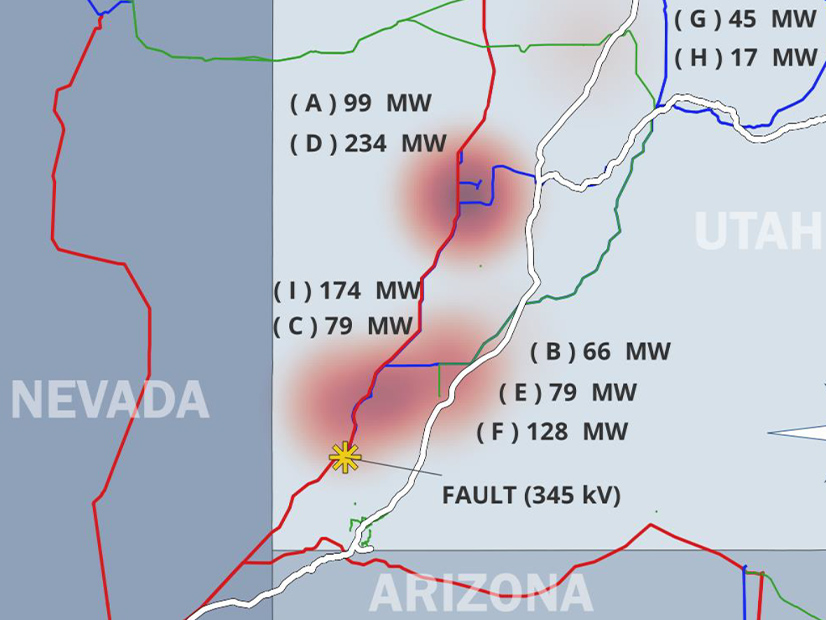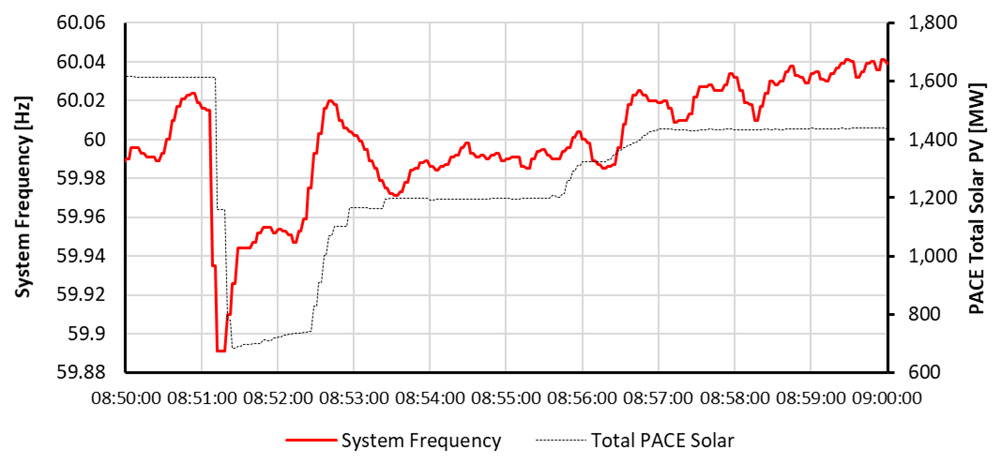The ongoing performance issues with inverter-based resources in the Western Interconnection show that “proactive industry action” is needed to prevent “a significant risk to [electric] reliability,” NERC and WECC said in an incident report released last week.
The 2023 Southwest Utah Disturbance, which occurred April 10, 2023, is the first major widespread loss of solar output to occur in the Western Interconnection outside of California. In the event, which involved nine solar facilities operated by PacifiCorp-East (PACE), the utility lost 921 MW of generation. This passed the 500 MW threshold to qualify the disturbance as a Category 1i event in NERC’s event analysis process, like the summer 2021 disturbances in Southern California that the ERO discussed in a report last year. (See NERC, WECC Repeat Solar Performance Warnings.)
The disturbance began at 8:51 a.m. Pacific time, when a single-line-to-ground fault occurred on a 345-kV transmission circuit in southwest Utah. While protective relaying cleared the fault within 3.5 cycles, PACE supervisory control and data acquisition records showed that aggregate solar output in the utility’s footprint dropped significantly; overall, PACE lost more than half the 1,600-MW total output of its solar fleet in less than half a minute, and the system frequency dropped from 60.01 Hz to 59.89 Hz.
Nine solar facilities were involved in the event; the lowest loss reported was 17 MW, and the highest was 234 MW. WECC and NERC found multiple reasons for the output reduction at all but one of the facilities:
-
- Inverter phase lock loop (PLL) loss of synchronism — five facilities;
- Instantaneous AC overvoltage (ACOV) — four facilities, all of which also suffered PLL loss of synch;
- DC reverse current protection — two facilities, both of which also suffered PLL loss of synch and ACOV;
- Inverter instantaneous AC overcurrent protection (ACOC) — two facilities; and
- Passive anti-islanding — one facility.
The facility that tripped on passive anti-islanding also suffered ACOC. In addition, two facilities tripped for unknown causes, which NERC and WECC attributed to “poor data retention and/or quality.”
All of the causes reported “have been well-documented in past disturbance reports,” NERC and WECC said; while they did not cite specific incidents, most of the same issues were cited in last year’s Southern California event report, as well as the ERO’s reports on the Odessa, Texas, disturbances of 2021 and 2022. (See NERC Repeats IBR Warnings After Second Odessa Event.)
The ongoing issues reiterate “the strong need for inverter-based resource (IBR) performance issues to be addressed by generator owners (GOs) in a timely manner,” the report said. One of its key findings was that NERC’s Project 2023-02 (Performance of IBRs) remains important, because it promises to require “analysis and mitigation of unexpected or unwarranted protection and control operations” from IBRs when such potential issues are identified.
In another of the report’s recommendations, the ERO noted the “reiterated need” for a comprehensive ride-through standard to replace PRC-024-3 (Frequency and voltage protection settings for generating resources). Revising this standard is the objective of Project 2020-02, which aims to ensure that generators remain connected to the electric grid during system disturbances.
Finally, the report said the incident illustrates the importance of following NERC’s Level 2 alert on IBRs, which the ERO issued this year. (See NERC Issues Level 2 Alert on IBR Issues.) The alert provided recommendations to GOs for addressing known performance issues with IBRs and requested information on existing facility protection and control settings.
Responses to the Level 2 alert were due by July 31; the ERO is analyzing the results and will publish key findings and recommendations by the end of the year. The report reminded GOs that these alerts “help ensure that [utilities] are aware of potential risk issues” with their grid-connected equipment and can develop corrective actions when possible.



